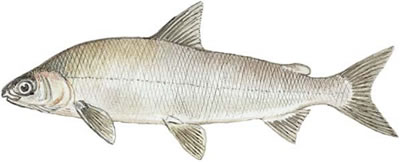The lake whitefish is a larger and more widespread fish than are the mountain and the round whitefish, and it is more highly regarded among anglers. A member of the Salmonidae family, the lake whitefish is a valuable commercial freshwater fish in Canada, although its numbers have declined due to environmental factors and overfishing, especially in the Great Lakes. The flesh—prepared fresh, smoked, and frozen—is considered superb in flavor, and its roe is made into an excellent caviar.
Identification
A slender, elongated species, the lake whitefish is silvery to white with an olive to pale greenish-brown back that is dark brown to midnight blue or black in some inland lake specimens; it also has white fins and a dark-edged tail. The mouth is subterminal and the snout protrudes beyond it, with a double flap of skin between the nostrils. The tail is deeply forked, and an adipose fin is present.
The lake whitefish is occasionally referred to as “humpback” because the head is small in relation to the length of the body, and older specimens may develop a hump behind the head. It has 10 to 14 anal rays, 70 to 97 scales down the lateral line, and 19 to 33 gill rakers. The body is more laterally compressed than that of the round or the mountain whitefish, which belong to a separate genus of “round whitefish.”
Size/Age
The lake whitefish is commonly 18 inches long and weighs 2 to 4 pounds. Some are said to reach as much as 31 inches, and the all-tackle world record is a 14-pound, 6-ounce fish caught in Ontario, Canada, in 1984. The average whitefish caught by anglers is in the 1- to 2-pound range. Fish of 4 or 5 pounds, and even larger, are sometimes caught. This species can live for 18 years.
Life history/Behavior
Spawning occurs in the late fall, when fish migrate into shallow areas over sandy bottoms or shoals in large lakes or tributary streams. Eggs are randomly deposited over the bottom by females laying up to 12,000 eggs per pound of body weight. These fish do not build nests, and parents return to deep water after spawning, leaving eggs unprotected on spawning grounds until they hatch the following spring. By early summer, the young move from shallow inshore areas to deeper water.
Food and feeding habits
Mainly bottom feeders, adult lake whitefish feed primarily on aquatic insect larvae, mollusks, and amphipods, but also on other small fish and fish eggs, including their own. Young fish feed on plankton.
Other Names
high back, bow back, buffalo back, or humpback whitefish; common whitefish; eastern whitefish; Great Lakes whitefish; inland whitefish; Sault whitefish; gizzard fish; Cree: atekamek; French: grand corégone.
Distribution
Lake whitefish occur throughout Alaska and Canada; in the mainland United States, they occur throughout central Minnesota and the Great Lakes and from New York to Maine. Transplanted populations exist in Washington, Idaho, and Montana. They have been stocked into high Andean lakes in a few countries in South America.
Habitat
Lake whitefish are named for their primary habitat of large, deep lakes, but they are also residents of large rivers. They prefer water temperatures of 50° to 55°F and will enter brackish water.


